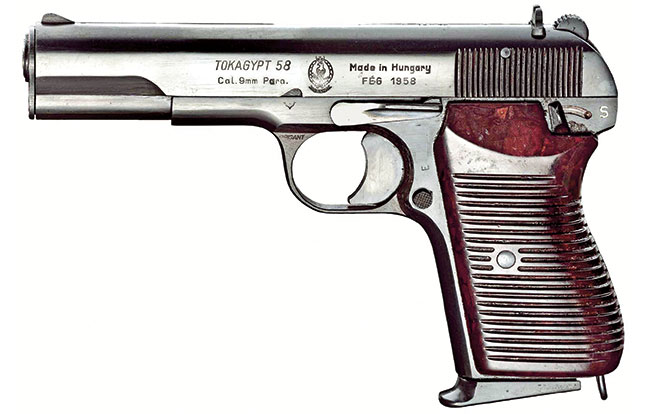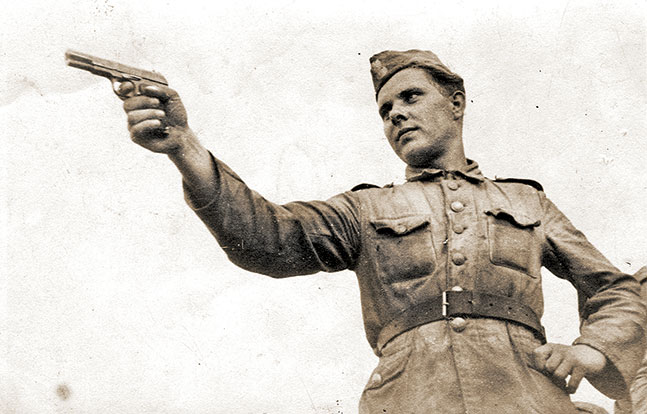The Soviet TT pistol of World War II fame is the short, semi-official name for the Tula Tokarev, with Tula being the city where the gun was designed and Tokarev from the pistol’s designer, Fedor Tokarev. The official designation of this pistol was “7.62mm Pistolet Tokareva obraztsa 1933 goda” (7.62mm Tokarev pistol of 1933 pattern). Developed during the late 1920s and early ’30s under the requirements of the Artillery Committee of the Red Army, this pistol was heavily influenced by two Browning designs—the Belgian-made FN M1903 and the U.S.-made Colt M1911. In fact, Tokarev conducted early tests of his detachable hammer unit using a modified FN M1903 pistol.
- RELATED: Russia’s Tokarev TT33 Military Pistol | Combat Pistols
- RELATED: Top 10 World War Guns From World War 2
The TT was designed in 1930 and then modified in 1933, and it was manufactured in the USSR until the early 1950s. As a testament to the design’s longevity, it is still made in countries like China and Serbia (formerly Yugoslavia). When it was first introduced, the TT was a rather modern pistol, simple to make and use, and with good accuracy and reliability. On the other hand, its 7.62mm jacketed bullet lacked the stopping power of larger rounds. The lack of any manual safety (except for a hammer’s half-cock notch) was the major flaw of the design. This was inspired by Cavalry Marshal Kliment Voroshilov, who once failed to switch off the safety on his Browning M1903 during a cavalry charge that took place during the Russian Civil War of 1918-22. With this fearful experience in mind, he told the designers to drop any manual safeties, and, not surprisingly, they complied with the “words of wisdom” from the leader of the Red Army.
In the USSR, TT pistols were manufactured in their home city of Tula, at the Tula Arms factory (TOZ). From 1942 on, TT pistols were also made in Izhevsk. It is believed that these factories produced more than 1,700,000 pistols between 1930 and 1953.
Advertisement — Continue Reading Below
The Tokarev TT pistol is a short-recoil-operated, locked-breech pistol with a Browning-type action. The barrel locks to the slide with two lugs that enter cuts on the underside of the slide; the tipping of the rear of the barrel upon recoil is controlled by a swinging link that connects the barrel and frame. The trigger is single-action with an exposed hammer and no manual safety. The only safety feature on the TT is a half-cock notch on the hammer, but it is considered insufficiently safe for carry with a loaded chamber. Normally, TT pistols were carried with an empty chamber and the hammer down. The hammer, along with its spring and sear, forms a single unit that is easily removed during field disassembly, simplifying the routine maintenance of the pistol. Magazines are single stack, with the magazine-release button located at the base of the triggerguard, on the left side. Sights are fixed, with the rear sight blade being dovetailed to the frame.
ComBloc Variants
Advertisement — Continue Reading Below
After the end of World War II, several Eastern European countries fell under the influence of the Soviet Union, and their newly established socialist governments aligned their armaments with that of the victorious Soviet Army. These countries initially included Hungary, Rumania and Poland. Each country possessed notable small arms production capabilities and, starting in 1946-1948, all began to manufacture TT pistols according to specifications and documentation supplied from the USSR. Pistols were made to the TT-33 pattern. The only notable differences between Soviet TT pistols and pistols made in the countries mentioned above were markings on the frame and slide and the style of grip panels.
In Poland, TT pistols were adopted as Pistolet wojskowy wzor 1948, or “Military pistol, model of 1948,” and the first pistols were made at the Radom plant in late 1946. Polish TT pistols made prior to 1950 featured plastic grips with the intertwined letters “P” and “W” (for “pistolet wojskowy”) and the “FB” factory logo in a triangle at the top of the slide. Polish TT pistols made between 1950 and 1955 featured unmarked serrated grips and factory code “11” in an oval at the top of the slide. Overall, about 225,000 TT pistols were made in Poland at the Radom small arms factory.
Hungarian TT pistols also were adopted in 1948, as Pisztoly 48 Minta, or 48M for short. Manufactured at the FEG factory in Budapest between 1948 and 1958, Hungarian 48M pistols featured both pre- and post-WWII-style slide serrations and two styles of the Hungarian crest embossed in the middle of plastic grip panels. The top of the slide was marked with factory code “02” between the serial number and the two last digits of the year of manufacture. In 1958, a large batch of modified TT pistols was manufactured for Egyptian contract under the model name of Tokagypt-58. These pistols featured improved plastic grip panels of more comfortable shape and, more importantly, an added manual safety located on the left side of the frame, in the cutout in at the top rear of the grip panel. Early Tokagypt-58 pistols were made in 9mm and were appropriately marked on the left side of the slide, along with the Egyptian crest, model name and a “Made in Hungary” label.
Advertisement — Continue Reading Below
For some reason the contract fell through and most of these pistols were sold commercially across Europe, and a few also made it to the U.S. from there. Late production Tokagypt pistols were also made with a “Super 12” mark rolled on the right side of the slide and “PARABELLUM cal 9mm + 7.62 TT” rolled on the left side of the slide. These pistols were supplied with two barrels in appropriate calibers.
Romanian TT pistols were made at the Cugir factory with a post-WWII style of slide serrations and with plastic grips embossed with a five-pointed star in the circle. The manufacturer code was a double triangle (one inside another) in front of the serial number on the frame.
Starting in the mid-1950s, the People’s Republic of China joined the club of TT manufacturing countries with the introduction of the Type 54 service pistol. It was also made in the post-1951 pattern, with “star in the circle” plastic grips. China was probably the biggest manufacturer of TT pistols after the USSR, issuing these pistols in large numbers to the People’s Liberation Army, the People’s Armed Police and also liberally exporting basic pistols and modifications to many countries across the world.
Advertisement — Continue Reading Below
China, along with the former Yugoslavia, also became the most prolific manufacturer of modified versions of the TT, offering export modifications with various styles of grips, added manual safeties and in optional chamberings like 9mm under a variety of names like Norinco Model 201 (in 7.62mm), Norinco Model 213 (in 9mm), M20, TU-90, etc. It seems that the Model 213B (a 9mm version with an added manual safety at the rear of the frame and plastic curved grips) is still manufactured by Norinco for commercial export. In some countries this model is also sold as the Norinco NP-17 pistol. Chinese pistols usually have a factory number in a triangle, next to the serial number that’s engraved on the frame.
The last of the TT manufacturing countries was the former Yugoslavia. Starting in 1957, M57 pistols were manufactured at the Crvena Zastava factory in the City of Kragujevac (today this is the Zastava Arms factory, located in the same city in the Republic of Serbia).
Unlike the military pistols described above, the M57 was not completely compatible with the original TT design, as it had a longer grip frame that hosted longer magazines with a nine-round capacity, as opposed to standard eight-round TT magazines. It must be noted that TT and M57 magazines are not compatible. M57 pistols featured grip panels similar in style to Soviet grip panels (made of plastic, with vertical serrations and a star with a circle in the middle), but instead of the “CCCP” located between the star points in Soviet TT pistols, Yugoslav M57 pistols had “SFRJ” in the same place. These letters, obviously, stood for “Socialist Federal Republic of Yugoslavia.” The left side of the slide was marked “7.62mm M57.”
Advertisement — Continue Reading Below
Since the 1970s, Crvena Zastava has also offered a commercial version of the M57 pistol known as M70B. Its primary difference is that it is chambered for 9mm. During the late 1980s, a compact version of the M70A was introduced as the M88. It has a shorter slide, barrel and grip, and wooden or plastic grip panels. Commercial export models are also offered with an optional slide-mounted safety as M57 (in 7.62x25mm), M70A (in 9mm) and M88A. Like Norinco, Zastava Arms still offers newly produced M57, M70A and M88 pistols despite the availability of more modern models.
Present-Day Surplus
Advertisement — Continue Reading Below
Commercially imported Polish pistols were modified at their home Radom factory with the installation of a safety lever just behind the trigger, on the left side of the frame. Safety positions are marked with a red dot for “fire” and a white dot for “safe.” Grip panels are replaced with new ones, unmarked with vertical serrations and thumb rest on the left.
Romanian pistols were imported into the U.S. as the TTC (TT Cugir), also with the added manual safety. The location of the safety lever is the same as with Polish pistols (left side of the frame, behind the trigger), but the safety lever is a bit beefier and the grip panels have no thumb rest.
Chinese commercial pistols are easily recognized by their manual safety located at the rear of the frame, above and behind the left grip panel. The safety lever points upwards, with or without color markings (rearward position is for fire, forward for safe). Grip panels could be of traditional TT style or of curved wraparound style.
Advertisement — Continue Reading Below
Yugoslav surplus (former military M57) pistols are often equipped with a large manual safety located at the rear of the frame, above the left grip panel. The safety lever points forward, with safe position being angled up and fire position being horizontal. When engaged, this safety locks the slide. Commercial TT-style pistols (M57, M70A, M88A) usually have a slide-mounted safety on the left side of the gun. Horizontal position is for fire, down is for safe.
There are basically two kinds of TT pistols available in the U.S. The first are original, unmodified guns, mostly individual bring-backs from various overseas conflicts, or early imports; the second groups consists of later commercial imports modified to suit ATF standards. These modifications usually include additional markings from the importer and, more importantly, the addition of a manual safety. At the time of publication, Century Arms had several of the variants covered in this piece in stock.
For more information, visit centuryarms.com or call 800-527-1252.
Advertisement — Continue Reading Below






























